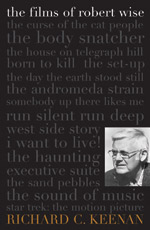(Scarecrow Press, 256 pages, $29.95)
By Richard C. Keenan
 Richard C. Keenan has written a thorough, heavily researched critical survey of Robert Wise’s impressive career. Wise was a director’s director who worked for five decades in Hollywood, often handling the producing reins in order to ensure as much control as possible over his finished product. His reputation has always been that of the consummate professional, a self-effacing, highly experienced filmmaker anxious to guide a project to the screen in the form most flattering to the original script, rather than to shape it to his own ego.
Richard C. Keenan has written a thorough, heavily researched critical survey of Robert Wise’s impressive career. Wise was a director’s director who worked for five decades in Hollywood, often handling the producing reins in order to ensure as much control as possible over his finished product. His reputation has always been that of the consummate professional, a self-effacing, highly experienced filmmaker anxious to guide a project to the screen in the form most flattering to the original script, rather than to shape it to his own ego.
Egoless is a pretty rare accolade in Hollywood, and probably a useful one for a fondly remembered president of the DGA. But it’s not the whole story, as Keenan makes clear. In stylistic terms, Wise was indelibly marked by the lessons he learned during his apprenticeship in the hothouse of inventiveness and low-budget creativity that was RKO in the 1940s. Working first under Orson Welles as editor on Citizen Kane, and then within the fabled and democratically organized Val Lewton production unit as a tyro director of low budget, atmospheric chillers like Curse of the Cat People, Wise, as his later work testifies, absorbed the lessons imparted by such stellar mentors. His black and white films through the late ’50s are consistently informed by the expressionist chiaroscuro compositions of Kane DP Gregg Toland, and enriched by Wise’s own taste for documentary realism and his early gift for visual effects. Also evident are Welles’ noirish visual touches, including information rich, long single takes that Wise would so often favor. Add to this the ingrained budget-conscious habits of the Lewton group and you have, Keenan argues, a rich foundation for a great career. And indeed, all these hallmarks of his approach are evident to varying degrees in movies as different from one another as West Side Story, The Day the Earth Stood Still and I Want to Live!
Keenan’s survey of Wise’s career contains clear and persuasive analyses of individual sequences and techniques. It reveals an artist determined to let his material live and breathe, and to value the story’s integrity above all else—no matter the genre, the budget, the style or the stars. Keenan also notes that in films where Wise did insert his own personal concerns—in the Vietnam-influenced The Sand Pebbles and the anti-racist Odds Against Tomorrow—the results were often less successful. But when all the evidence is in, he concludes that Wise’s consistency, sobriety, technical perfectionism and a hands-off approach add up to a recognizable and admirable aesthetic all its own.
Review written by John Patterson.